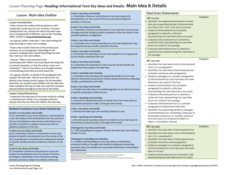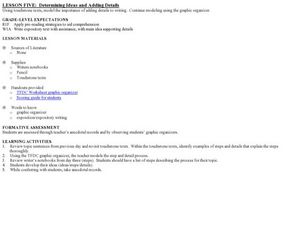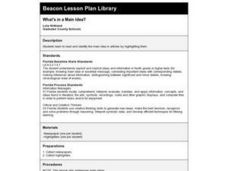Curated OER
Paragraphs: Main Idea and Supporting Details
This is a great way to review the concept of main idea and supporting details with younger learners. Learners read two short passages and identify the main idea and supporting details using visual prompts and a graphic organizer.
For the Teachers
Main Idea Outline
Find the main idea in an informational text with a versatile lesson. Three levels of differentiation help you implement the strategy in any age or class level, based on the ability and objectives of your learners.
Curated OER
Determining Ideas and Adding Details
A handy TFDC (topic/fact/detail/conclusion) graphic organizer (included) allows young writers to outline and record their main ideas and supporting details in the prewriting phase. They then continue to add details to the topic sentences...
K12 Reader
The Jungle Book
Young readers complete a graphic organizer identifying the main idea and the supporting ideas in a passage taken from Rudyard Kipling's The Jungle Book.
Curated OER
Build Masters: Identifying Details
Find key details in books using this note card strategy. Each reader gets six cards with the classic who, what, where, when, why, and how detail prompts. After they read the book, they choose a card and locate a key detail answering the...
Orange County Schools
Piggybook
Summarizing text is a balancing act between being brief but thorough. You need to be short and to the point, but also cover all the important details, a task that presents a challenge for many young learners. In this lesson based on the...
Weebly
Author Study: Eric Carle
Dive into an author study of one of the most beloved children’s book authors, Eric Carle. After reading some of his stories, including Papa Get me the Moon, A House for Hermit Crab, The Grouchy Ladybug, and The Very Busy Spider, readers...
Curated OER
When the Fly Flew In
Explore visual and verbal recall and sequencing with your youngsters. Start by reading a story and completing a worksheet after listening to the story. They work to identify the main idea and supporting details. The worksheet is included...
DePaul University
Learn about Fables
Expose young readers to a new genre of fiction with a short reading passage. After learning about fables, children identify the main idea and supporting details in preparation for writing a short summary. Read the text as a class,...
Curated OER
What's in a Main Idea?
Second graders read newspaper articles. In this language arts lesson, 2nd graders identify the main ideas found in the articles by highlighting them. The entire class selects one interesting article from the sports section to discuss.
Curated OER
Write a Story
Here is a great way to explore narrative writing! Learners review a previously constructed story map and identify the characters, setting, and main events in the book Anansi and the Moss-Covered Rock retold by Eric A. Kimmel. They...
Curated OER
Mapping Out the Story
Discuss the reading comprehension strategy of summarization with your elementary schoolers! They read a chapter from their social studies textbook, Regions Near and Far, and create a map, or word web, for the chapter. They identify...
Curated OER
Goodnight Goon
Students identify fictional story elements. For this reading comprehension lesson, students read the book Goodnight Goon, which is a parody of Goodnight Moon, and discuss the story elements. Students use an included worksheet to record...
Pennsylvania Department of Education
Comparing Key Ideas and Details in Fiction and Nonfiction
Students recognize the differences between fiction and nonfiction texts. In this genre study instructional activity, students discuss what nonfiction means and write the definition. Students listen to a read aloud and vote whether the...
Curated OER
Scrapbook of Evidence
Students read three different genres of fiction. They create a story map and brainstorm possible collage inclusions. Each student prepares a minimum of two scrapbook page entries for each text or passage. Students write beside each...
Curated OER
Printing and Publishing
Explore African literature and artwork in a multicultural literacy and art lesson. Begin with a read aloud of Tiger and the Big Wind: A Tale from Africa, and afterward, have kids retell the main events in the story. They identify and...
Pennsylvania Department of Education
Analyzing Key Ideas and Details in Nonfiction
Students explore nonfiction texts. In this language arts instructional activity, students read a nonfiction text and make predictions. Students identify facts and opinions in the text and draw conclusions as they read.
Curated OER
Nursery Rhymes
Students recall details of nursery rhyme read by teacher, identify main characters, and demonstrate knowledge of poem by creating concept map about story that includes title, clip art, and changes in font and color.
Curated OER
Identifying Differences Between Fiction and Nonfiction Books
Students explore the differences between fiction and non-fiction book. In this genre study instructional activity, students read examples of fiction and non-fiction and identify the characteristics of each genre. Students list the...
Smekens Education Solutions, Inc.
Introducing the 6 Traits to Students
Put together an English language arts unit on the six traits of writing with this helpful collection of resources. From fun songs to differentiated writing exercises reinforcing each of the traits, great ideas are provided for developing...
Houghton Mifflin Harcourt
Nature Walk: English Language Development Lessons (Theme 2)
Walking in nature is the theme of a unit designed to support English language development lessons. Scholars look, write, speak, and move to explore topics such as camping, woodland animals, instruments, bodies of water, things found at a...
University of Kansas
Newspaper in the Classroom
Newspapers aren't only for reading—they're for learning skills, too! A journalism unit provides three lessons each for primary, intermediate, and secondary grades. Lessons include objectives, materials, vocabulary, and procedure, and...
Curated OER
In a Nutshell....
Students examine how to summarize the most important details in a reading passage in order to increase their comprehension. They design a story web using the summarization skills. Before class, they complete a reading assignment prior to...
Curated OER
The Main Man
Students explore visualizing stories by completing a graphic organizer. In this reading strategy lesson, students read the story Pecos Bill by Steven Kellog and identify the setting, main characters and their interpretations. Students...

























